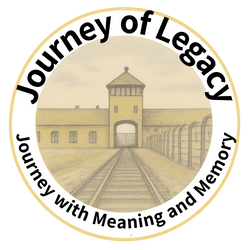Locations We Will Visit On This Trip
Warsaw
Our journey begins in Warsaw, Poland’s capital and a city deeply scarred and shaped by the Holocaust. Once home to a thriving Jewish population, Warsaw bore witness to the horrors of the Nazi occupation and the heroism of the Jewish resistance. On our walking tour, we visit the POLIN Museum of the History of Polish Jews, a world-renowned institution that offers a rich, immersive narrative of over a thousand years of Jewish life in Poland. We continue to the Umschlagplatz, the deportation point where hundreds of thousands of Jews were forced onto trains bound for Treblinka. At the vast and haunting Warsaw Jewish Cemetery, we reflect on the scale of loss and the enduring legacy of those buried there. These visits offer powerful context for the days ahead.
Treblinka
Located northeast of Warsaw, Treblinka was one of the deadliest Nazi extermination camps, where an estimated 700,000 to 900,000 Jews were murdered in just a few months of operation. Although the camp was destroyed by the Nazis in an attempt to hide their crimes, today the site is marked by a powerful memorial landscape of symbolic stones and a solemn museum. Our visit to Treblinka is quiet, respectful, and deeply moving—a chance to contemplate the industrial scale of genocide and honor those who perished. This visit sets the tone for the moral gravity of the journey.
Lublin
We travel southeast to Lublin, a city that was once a vibrant center of Jewish religious and intellectual life. Before the war, Jews made up a third of Lublin’s population. During the Holocaust, the city became the headquarters of Operation Reinhard, the Nazi plan to exterminate Polish Jews. Lublin’s Jewish quarter and its few remaining synagogues are a testament to a rich culture nearly erased. Our time here bridges the historical and personal dimensions of the Holocaust, offering insight into the daily lives of Polish Jews before and during the war. Lublin is also the gateway to the nearby Majdanek camp.
Majdanek
Just outside Lublin, Majdanek stands as one of the most intact Nazi concentration and extermination camps in Europe. Unlike other camps, Majdanek was liberated before the Nazis could destroy it. Visitors can see original barracks, gas chambers, crematoria, and the striking mausoleum that holds the ashes of victims. A visit here is both educational and profoundly emotional. The scale of preservation makes Majdanek a stark, unfiltered encounter with history, offering a visceral sense of what life and death were like under the Nazi regime.
Belzec
Belzec was the first of the Operation Reinhard extermination camps to be built, and in just six months, approximately 430,000 to 500,000 Jews were murdered there. Only a handful of people survived to tell the story. Today, a minimalist yet impactful memorial covers the site, with a museum that details the camp’s horrifying efficiency. The entire area is treated as a sacred space, honoring those who were never given graves. Our visit to Belzec is brief but unforgettable, a necessary stop on the path of remembrance.
Krakow
In stark contrast to the previous days, Krakow offers a glimpse into the richness of Jewish life before the Holocaust. Once home to tens of thousands of Jews, the city retains deep traces of its Jewish heritage, particularly in the district of Kazimierz. Our tour includes the beautifully preserved Old Town, where history and modern life intertwine. We explore bustling squares, cobbled streets, and historic landmarks, setting the stage for the more somber visits to come. Krakow is a city of dualities—life and loss, memory and revival.
Auschwitz-Birkenau
The centerpiece of the tour is a full day visit to Auschwitz I and Auschwitz II–Birkenau. At Auschwitz I, we walk beneath the infamous “Arbeit Macht Frei” gate and explore original barracks, exhibits, and preserved facilities that reveal the brutal realities of life in the camp. In the afternoon, we visit Birkenau, the massive death camp purpose-built for extermination, with remains of gas chambers, rail lines, and watchtowers. This visit is a harrowing and essential experience that offers deep historical understanding and personal reflection.
Kazimierz & Wieliczka Salt Mine
We return to Kazimierz, Krakow’s historic Jewish quarter, to walk its storied streets and visit the Galicia Jewish Museum, which offers personal and photographic insights into Jewish life before and after the Holocaust. Optional visits to the former Oskar Schindler Factory are also available for those interested. As a powerful conclusion to the trip, we journey underground to the 700-year-old Wieliczka Salt Mine—a stunning site of natural beauty and human ingenuity. With chapels carved from salt and underground lakes, it’s a reminder that even in a journey marked by tragedy, there is also wonder, resilience, and awe.
